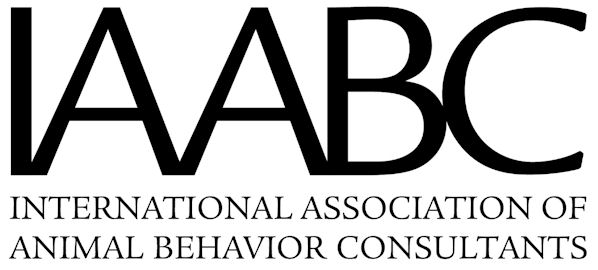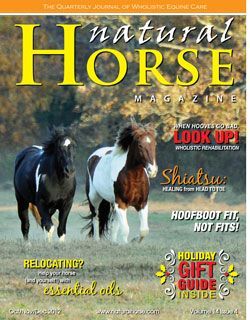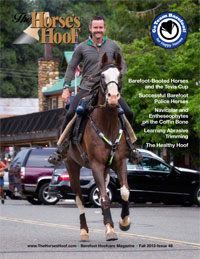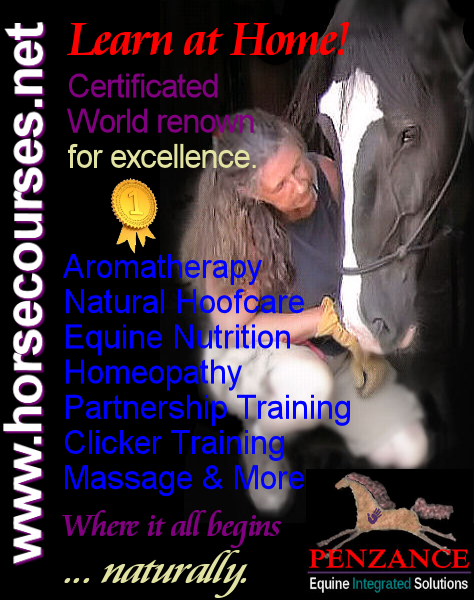 From a discussion forum today:
From a discussion forum today:
Today at 7:58am, jp wrote:
|
Let me explain a bit.  I am usually the one ppl call when ‘nothing else works’ for aggressive and dangerous horses. (same thing with hooves — when all else fails, ppl call me. Wish they’d call me FIRST and then most of the issues wouldn’t be issues at all! *grin*) So yes, I need to get the horse’s attention on ME … and how best to do that then to establish my Leadership. HED (hind end disengagement) does this nicely and I’ve never had it fail. But people seem to think that if the horse merely walks around in a small circle then that will ‘do it’. Nope. That’s why I explain that the horse has to PIVOT on the front end while the hind end moves/jumps over (inside leg crossing outside). The action of the HED will unstick a sticky mind AND put me in the position of being able to ‘move the other horse’s feet’, so to speak. That sets me one rung higher up on the hierarchical ladder with the horse. Fact of equine social rules — a horse is ‘hardwired’ to HAVE to be a leader or a follower and there’s no in between. Yes, can graze and be equal partners/friends but when in situation that needs fleeing? The leader lets the follower know when/why/where/how fast, etc. to go. So I like to set myself up right at the get go with a horse to be the leader. When one has 1600# of horse double barreling at you or coming at you teeth first then its rather an important point. And horses with PHOBIAS are even more difficult to work with than those with PTSD cause the phobias tend to make any critter a bit …. ummmm … crazy! *LOL* Anyway …. hope that explains the HED.
I am usually the one ppl call when ‘nothing else works’ for aggressive and dangerous horses. (same thing with hooves — when all else fails, ppl call me. Wish they’d call me FIRST and then most of the issues wouldn’t be issues at all! *grin*) So yes, I need to get the horse’s attention on ME … and how best to do that then to establish my Leadership. HED (hind end disengagement) does this nicely and I’ve never had it fail. But people seem to think that if the horse merely walks around in a small circle then that will ‘do it’. Nope. That’s why I explain that the horse has to PIVOT on the front end while the hind end moves/jumps over (inside leg crossing outside). The action of the HED will unstick a sticky mind AND put me in the position of being able to ‘move the other horse’s feet’, so to speak. That sets me one rung higher up on the hierarchical ladder with the horse. Fact of equine social rules — a horse is ‘hardwired’ to HAVE to be a leader or a follower and there’s no in between. Yes, can graze and be equal partners/friends but when in situation that needs fleeing? The leader lets the follower know when/why/where/how fast, etc. to go. So I like to set myself up right at the get go with a horse to be the leader. When one has 1600# of horse double barreling at you or coming at you teeth first then its rather an important point. And horses with PHOBIAS are even more difficult to work with than those with PTSD cause the phobias tend to make any critter a bit …. ummmm … crazy! *LOL* Anyway …. hope that explains the HED.
As for the swinging rope. It’s p.r.e.s.s.u.r.e. Yep — not in +R but in -R. I start out asking the horse simply to move out of my personal space by focusing on ‘my space’ (not on the horse’s body). I ask this twice. If no response I focus on the BODY part of the horse I wish him/her to move. Twice. No response? I then will wiggle or swing the rope at the horse to increase my pressure. It’s not a trademarked Parelli “thang” – he didn’t ‘invent’ this … it is what it is and always has been — its a way to increase the pressure and expand a human’s energy so the horse can clearly understand. With many/most of the horses I work with some horses just have never had this explained to them as the human involved has “reacted” from fear and run away or contrarily gotten aggressive with the horse and caused the horse more reason to be defensive and aggressive himself. So, using the rope or the whip is one of the first ‘lessons’ learned by the horse if needed to understand that he/she may NOT come into my space uninvited (at first) and he/she MUST respect it. And, visa versa, I will respect them. It’s a lesson in cross-species communiations. *GRIN* …. My goal is always to get to the point where I merely have to LOOK and request the horse to back up, sidestep, move forward, etc. But sometimes its a bit rough to start off. And just for the record — with extremely aggressive horses (ones that have totally by-passed the ‘flee’ and go instantly into the ‘fight’ mode) … I use ONLY +R with that horse to start. That’s it. When one can’t even approach the stall door or the paddock fence without a horse whipping itself around to come kill you with his/her teeth, then its +R all the way! *grin* … so it depends … there are NO ‘absolutes’ when working with horses. If one is under that impression then there’s a whole lotta ‘lessons’ the horse will be teaching that human! *LOL*
Oh, and PS … “Earl” the horse with whom I was working in that ‘first video’ was reputed to be pushy, dominant, running over and through his humans even with the use of a chain over his nose (that’s how he had been ‘controlled’) – he also would bolt from the mounting block and dump his riders – he had never stood quietly at the mounting block … he bit me on the elbow and I needed to let him know that biting the human is unacceptable. After I let him know through moving his feet we had no issues after that … no aggressive/defensive issues. His total demeanor changed. He moved around when he was unsure and uncomfortable. That was fine. I let him move. He needed to do that and disperse some of the anxiety and work through some phobia. I rewarded him for stopping and standing still. I rewarded him for big exhales (disperses phobias). The whole presentation was about an hour. I ‘talked’ overtime for about 40 mins and then worked with Earl for the remaining 20. At the end of the 20 mins he was standing calmly and quietly, unrestrained, for a strange, nervous rider to step up the mounting block and lean over him. The (older woman) rider was not comfortable climbing onto his back and that was fine. Her gut was telling her something and we all need to listen to our guts more often.  So in the end all was well. Earl was doing well and standing quietly at the mounting block (that was the original exercise – to help him learn to stand quietly at the mounting block). Unfortunately, the next day another handler worked with Earl who is a bit more ‘aggressive’ and aggressively ‘energetic’ and Earl was shown to respond in kind … reactive, bracing, tense, frightened. etc. The other handler uses a whip to ‘sting/hurt’ the horse into moving his body and ridicules CT totally. The horse in the video, (Earl) was clearly afraid of this 2nd handler as presented by his body language and although he DID do as he was being demanded to do he was tense, bracing, head up, tightly clamped tail, posturing avoidance behavior, flee behavior. Etc. I had the video with still shots of Earl to show the behaviors resulting from -P (negative punishment) in contrast to +R (and -R) — the handler was totally blocked out so identification was impossible as that was NOT my intent to pit ‘trainer against trainer’. It was to exhibit typical equine behaviors and posturings. Earl displayed very typical equine behaviors in the shots that I used and I wanted to have others see that behavior so they can recognize in their own handling. There are studies proving the effects of positive reinforcement vs. ‘punishment’ of which I wanted to show pictorially for those who don’t like to read much. (studies CAN be a bit long and verbose!) But, the 2nd day handler recognized herself and requested the video be removed so that’s why its gone. I’ll remake somehow in another manner when the time arises.
So in the end all was well. Earl was doing well and standing quietly at the mounting block (that was the original exercise – to help him learn to stand quietly at the mounting block). Unfortunately, the next day another handler worked with Earl who is a bit more ‘aggressive’ and aggressively ‘energetic’ and Earl was shown to respond in kind … reactive, bracing, tense, frightened. etc. The other handler uses a whip to ‘sting/hurt’ the horse into moving his body and ridicules CT totally. The horse in the video, (Earl) was clearly afraid of this 2nd handler as presented by his body language and although he DID do as he was being demanded to do he was tense, bracing, head up, tightly clamped tail, posturing avoidance behavior, flee behavior. Etc. I had the video with still shots of Earl to show the behaviors resulting from -P (negative punishment) in contrast to +R (and -R) — the handler was totally blocked out so identification was impossible as that was NOT my intent to pit ‘trainer against trainer’. It was to exhibit typical equine behaviors and posturings. Earl displayed very typical equine behaviors in the shots that I used and I wanted to have others see that behavior so they can recognize in their own handling. There are studies proving the effects of positive reinforcement vs. ‘punishment’ of which I wanted to show pictorially for those who don’t like to read much. (studies CAN be a bit long and verbose!) But, the 2nd day handler recognized herself and requested the video be removed so that’s why its gone. I’ll remake somehow in another manner when the time arises.  My mission is to make POSITIVE REINFORCEMENT (and negative reinforcement when needed) the highlight of teaching horses. Too many use ‘punishment’ (yes, even the ‘gurus’) and don’t realize that they’re not teaching the horse lessons but teaching the horse fear/avoidance behaviors. So … onward we go!
My mission is to make POSITIVE REINFORCEMENT (and negative reinforcement when needed) the highlight of teaching horses. Too many use ‘punishment’ (yes, even the ‘gurus’) and don’t realize that they’re not teaching the horse lessons but teaching the horse fear/avoidance behaviors. So … onward we go! 












Reblogged this on researchesofjoannemariesworld and commented:
thank you for posting your comment earlier, I will check it out! and thanks for the word press! It takes Time!